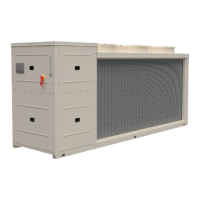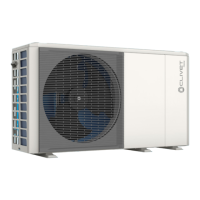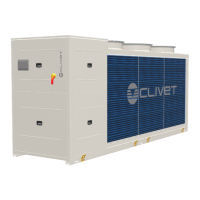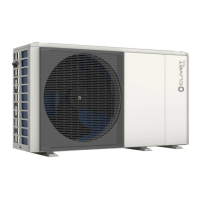
Do you have a question about the CLIVET WiSAT-YEE1 Series and is the answer not in the manual?
General safety regulations and personal protective equipment (PPE) guidelines.
Unit design principles and awareness of residual risks for user safety.
Defines the specific applications and limitations for unit operation.
Importance of planning periodic maintenance to optimize performance and reduce costs.
Immediate actions and procedures to follow in case of unit malfunction.
Installer's responsibility to train users on unit operation and safety.
Immediate actions to take when the unit experiences a breakdown.
Information regarding the unit's serial number label and identification.
Data required from the unit for effective technical assistance.
Details on the refrigerant type, safety class, and GWP.
Procedures for checking unit delivery for damage and correctness.
Recommended environmental conditions for unit storage.
Safe procedures and necessary equipment for handling the unit.
Site selection criteria based on regulations, altitude, and factors.
Required spaces for proper unit operation and maintenance access.
Best practices and considerations for unit placement.
Ensuring unobstructed airflow for optimal unit performance.
Designing pipes to minimize pressure drops and optimize performance.
Importance of water quality and parameters for copper corrosion limits.
Procedures for cleaning the system before connecting the unit.
Washing procedures required for new water installations.
Rinsing procedures necessary for existing water systems.
Measures to prevent freezing in water connections and the unit.
Requirements for project water flow-rate for proper functioning.
Function and correct installation of the flow switch.
Installation guidelines and mesh size for the water filter.
Steps to follow before starting the unit's pump.
Unit specific electrical data and matriculation plate information.
Specifications for the electrical supply network connection.
Guidelines for routing and installing signal and data cables.
Specifications for controller wiring, including cable size and torque.
Terminal block details for customer connections to the unit.
Functionality and setup for remote control of the unit.
Checklist for initial unit start-up with power supply OFF.
Checklist for initial unit start-up with power supply ON.
Checks and operations for the unit's refrigeration circuit.
Verification and connection procedures for the electric circuit.
Overview of the control panel interface and layout.
Description of control panel buttons and their functions.
Explanation of icons displayed on the unit's control interface.
Navigating menus to configure date, time, and language settings.
Procedure for adjusting the unit's operational mode and temperature.
Functionality and activation method for dual setpoints.
Description of the snow protection feature and its operation.
Adjusting the unit's sound emission levels for quieter operation.
Accessing and displaying various unit operational data and status.
Setting daily or weekly operating schedules for the unit.
List of alarm codes and their corresponding descriptions for troubleshooting.
Safety checks required before performing operations on refrigerant systems.
Standardized procedures to minimize risks during refrigerant operations.
Prohibition of ignition sources near refrigerant systems to prevent fire.
Approved methods for identifying refrigerant leaks.
Procedures for safely removing and evacuating refrigerant.
Requirements and precautions for refrigerant charging.
Safe procedures for dismantling the unit and its components.
Best practices for safe refrigerant recovery during service or decommissioning.
Essential safety precautions to be followed during maintenance.
Who should perform maintenance and its benefits for unit efficiency.
Recommended intervals for performing unit inspections.
A table outlining maintenance tasks and their recommended frequencies.
Procedures for cleaning and checking the water side exchanger.
Cleaning procedures and safety precautions for the air side exchanger.
Maintenance, calibration, and replacement guidelines for leak detectors.
Details on anti-vibration mount types, dimensions, and part codes.
Specifics and details for seismic-resistant anti-vibration mounts.
Procedures for unit disconnection and recovery of fluids.
Guidelines for proper disposal of waste electrical and electronic equipment.
Overview of common risk situations not controllable by the manufacturer.
Identification of risks associated with unit handling operations.
Risks associated with incorrect installation procedures.
Dangers and risks related to the unit's electrical components.
Risks associated with moving components like fans and transmissions.
Hazards and risks related to refrigerant exposure and handling.
Procedures for connecting multiple units via the X-Y-E BUS.
Explanation of how the master unit manages system control.
Setting unique addresses for each unit in a modular configuration.
Behavior of system alarms and their impact on unit operation.
Details of the Modbus communication protocol and specifications.
Table listing Modbus registers, data types, and descriptions.
Technical performance data for Excellence SC models.
Technical performance data for Excellence LN models.
Technical performance data for Premium SC models.
Technical performance data for Premium LN models.
Technical performance data for Excellence EN models.
Detailed construction specifications for Excellence series units.
Detailed construction specifications for Premium series units.
Normal operating temperature and humidity limits for the unit.
Conditions where the use of glycol is mandatory for operation.
Sound power and pressure levels for Excellence series models.
Sound power and pressure levels for Premium series models.
Calibration values for various overload and control devices.
Overall dimensions and weights for EXC/PRM models 45.4 to 60.4.
Overall dimensions and weights for EXC/PRM models 65.4 to 90.4.











